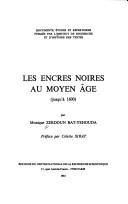| Listing 1 - 4 of 4 |
Sort by
|
Book
ISBN: 9789004444805 9004444807 9004421114 9789004421110 Year: 2021 Publisher: Leiden;Boston BRILL
Abstract | Keywords | Export | Availability | Bookmark
 Loading...
Loading...Choose an application
- Reference Manager
- EndNote
- RefWorks (Direct export to RefWorks)
Traces of Ink. Experiences of Philology and Replication is a collection of original papers exploring the textual and material aspects of inks and ink-making in a number of premodern cultures (Babylonia, the Graeco-Roman world, the Syriac milieu and the Arabo-Islamic tradition). The volume proposes a fresh and interdisciplinary approach to the study of technical traditions, in which new results can be achieved thanks to the close collaboration between philologists and scientists. Replication represents a crucial meeting point between these two parties: a properly edited text informs the experts in the laboratory who, in turn, may shed light on many aspects of the text by recreating the material reality behind it. Readership: Historians of premodern science, philologists working on the Graeco-Roman, Syriac, and Arabic tradition, along with chemists and natural scientists, in particular those cooperating with humanists.
091:003.5 --- 003.5 --- 667.4 --- Ink --- Writing materials and instruments --- 667.4 Writing inks --- Writing inks --- 003.5 Schrijfmaterialen --- Schrijfmaterialen --- 091:003.5 Handschriftenkunde. Handschriftencatalogi-:-Schrijfmaterialen --- Handschriftenkunde. Handschriftencatalogi-:-Schrijfmaterialen --- Writing --- Office equipment and supplies --- History --- Materials and instruments --- E-books --- Ink - History - To 1500 --- Writing materials and instruments - History - To 1500 --- History of science
Book
ISBN: 9783110578133 9783110575729 3110575876 3110578131 9783110575873 9783110709612 3110575728 Year: 2018 Publisher: Berlin De Gruyter
Abstract | Keywords | Export | Availability | Bookmark
 Loading...
Loading...Choose an application
- Reference Manager
- EndNote
- RefWorks (Direct export to RefWorks)
Owing to its relatedness to parchment as the primary writing matter of the Middle Ages, human skin was not only a topic to write about in medieval texts, it was also conceived of as an inscribable surface, both in the material and in the figurative sense. This volume explores the textuality of human skin as discussed by Geoffrey Chaucer and other writers (medical, religious, philosophical, and literary) of the fourteenth and fifteenth century. It presents four main aspects of the complex relations between text, parchment, and human skin as they have been discussed in recent scholarship. These four aspects are, first, the (mostly figurative) resonances between parchment-making and transformations of human skin, second, parchment as a space of contact between animal and human spheres, third, human skin and parchment as sites where (gender) identities are negotiated, and fourth, the place of medieval skin studies within cultural studies and its relationship to the major concerns of cultural studies: the difficult demarcation of skin from body, the instability of any inscription, and the skin’s precarious state as an entity of its own.
Literature, Medieval --- 091:003.5 --- 930.85.42 --- 091.14 --- 930.85.42 Cultuurgeschiedenis: Middeleeuwen --- Cultuurgeschiedenis: Middeleeuwen --- 091.14 Codicologie. Codices. Scriptoria --- Codicologie. Codices. Scriptoria --- 091:003.5 Handschriftenkunde. Handschriftencatalogi-:-Schrijfmaterialen --- Handschriftenkunde. Handschriftencatalogi-:-Schrijfmaterialen --- History and criticism --- E-books --- Book history --- anno 1300-1399

ISBN: 2222029724 9782222029724 Year: 1983 Publisher: Paris CNRS
Abstract | Keywords | Export | Availability | Bookmark
 Loading...
Loading...Choose an application
- Reference Manager
- EndNote
- RefWorks (Direct export to RefWorks)
Manuscripts. Epigraphy. Paleography --- anno 500-1499 --- Ink --- History --- Science, Medieval --- 091.14:003.5 --- 667.5 --- -Science, Medieval --- Medieval science --- Writing materials and instruments --- Codices--Schrijfmaterialen --- Printing inks (black or coloured). Lithographic inks. Chalks. Writing and drawing pencils. Coloured crayons --- Science, Medieval. --- History. --- 667.5 Printing inks (black or coloured). Lithographic inks. Chalks. Writing and drawing pencils. Coloured crayons --- 091.14:003.5 Codices--Schrijfmaterialen --- Encre --- Histoire --- book history --- ink --- Ink - History --- Ecriture --- Codicologie --- Moyen age --- Materiel et instruments
Book
ISBN: 9789004311275 9789004312340 Year: 2016 Publisher: Leiden Koninklijke Brill NV
Abstract | Keywords | Export | Availability | Bookmark
 Loading...
Loading...Choose an application
- Reference Manager
- EndNote
- RefWorks (Direct export to RefWorks)
091 <51> --- 091 =951 --- 025.7 --- 003.5 --- S15/0313 --- Handschriftenkunde. Handschriftencatalogi--China --- Handschriftenkunde. Handschriftencatalogi--Chinees --- Conserveren van boeken. Inbinden. Microfilmeren. Digitaliseren --- Schrijfmaterialen --- China: Language--Inscriptions on bamboo and wood: general --- Manuscripts, Chinese --- Qing hua da xue (Beijing, China) --- 091 <51> Handschriftenkunde. Handschriftencatalogi--China --- 003.5 Schrijfmaterialen --- 025.7 Conserveren van boeken. Inbinden. Microfilmeren. Digitaliseren --- 091 =951 Handschriftenkunde. Handschriftencatalogi--Chinees --- Qing hua da xue (Beijing, China).
| Listing 1 - 4 of 4 |
Sort by
|

 Search
Search Feedback
Feedback About UniCat
About UniCat  Help
Help News
News